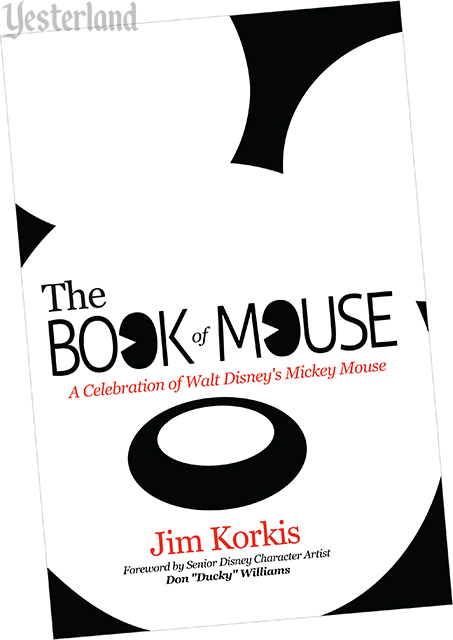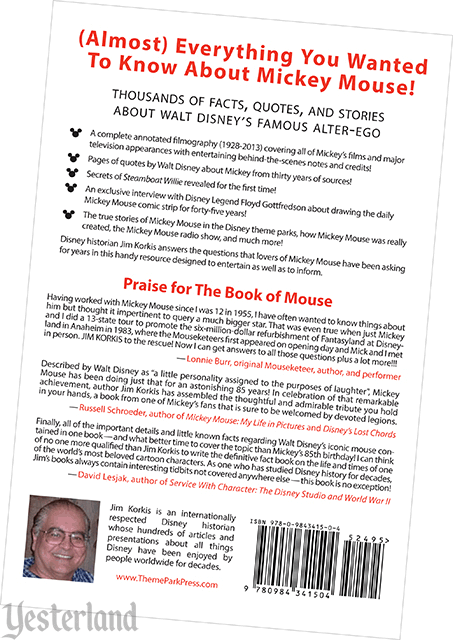|
|||||
|
|||||
|
A whole book about Mickey Mouse? Without pictures? Yes. My friend Jim Korkis, whose The Vault of Walt Volume 2 was released less than two months ago, has a second new book for the holidays. It’s The Book of Mouse, A Celebration of Walt Disney’s Mickey Mouse. This time, instead of a collection of essays dealing with Walt Disney, Disney films, Disney parks, and miscellaneous Disney subjects, the focus is on Mickey Mouse. But there’s a distinct similarity anyway. Once again, stories deal with Walt Disney, films, parks, and other areas—but always relating to Mickey Mouse. |
|||||
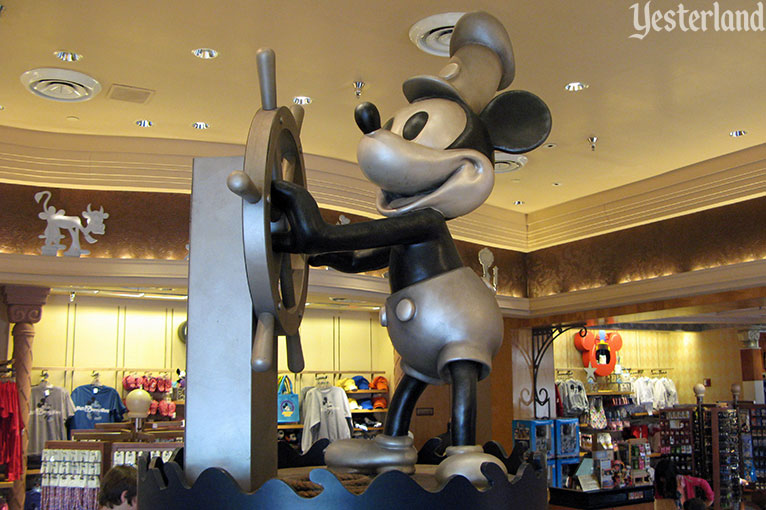
Photo by Werner Weiss, 2011 Mickey from Steamboat Willie (1928) at Mickey’s of Hollywood, Walt Disney World |
|||||
|
The Book of Mouse is not structured as a chronological narrative. It’s a collection of stories, anecdotes, quotations, and FAQ-like question-and-answer sections, with a complete Mickey Mouse annotated filmography somewhere in the middle. (See the contents listing later in this review.) Although Korkis included a wide range of topics about Mickey Mouse, including everything that’s really significant, he doesn’t attempt to present a comprehensive look at Mickey Mouse’s 85 years the way a biographer attempts to present a subject’s life. The Book of Mouse assumes the reader already has familiarity with Mickey Mouse. The reader then discovers all sorts of interesting, entertaining, and surprising details—and even learns that some of what he or she already knew is actually wrong. |
|||||
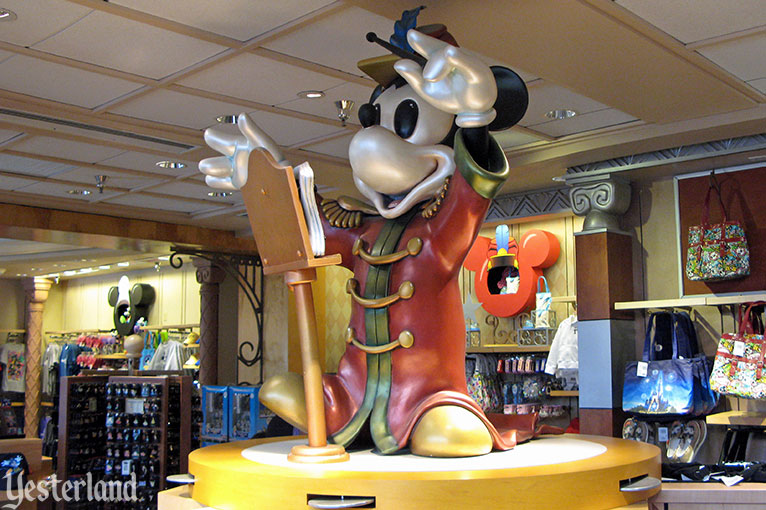
Photo by Werner Weiss, 2011 Mickey from The Band Concert (1935) at Mickey’s of Hollywood, Walt Disney World |
|||||
|
As with The Vault of Walt books, you don’t have to read the book in any particular order. You can bounce around and it still makes sense. Korkis makes sure that chapters and sub-chapters are self-contained. The book does not follow a chronological order, and the book’s early chapters are not prerequisites for understanding the later chapters. There’s something appealing about a book that readers can approach so casually, but there’s also a downside to it. It means there’s sometimes repetition. For example, the story of distributor Charles Mintz secretly hiring Walt Disney’s animators to make Oswald the Lucky Rabbit cartoons more cheaply is repeated in three places. First, it’s at the beginning of the book in “MOUSE-CE-LLANEOUS” as part of the answer to, “How Was Mickey Mouse Created?” Then, around a hundred pages later, it’s in “First Mickey Mouse Cartoon: Plane Crazy.” And it’s back in the very next story, “The Making of Steamboat Willie.” Don’t worry. Korkis did not copy and paste the same wording each time. It’s told in the context of that chapter, but the reader is likely to wonder, Didn’t I already read that in this book? |
|||||
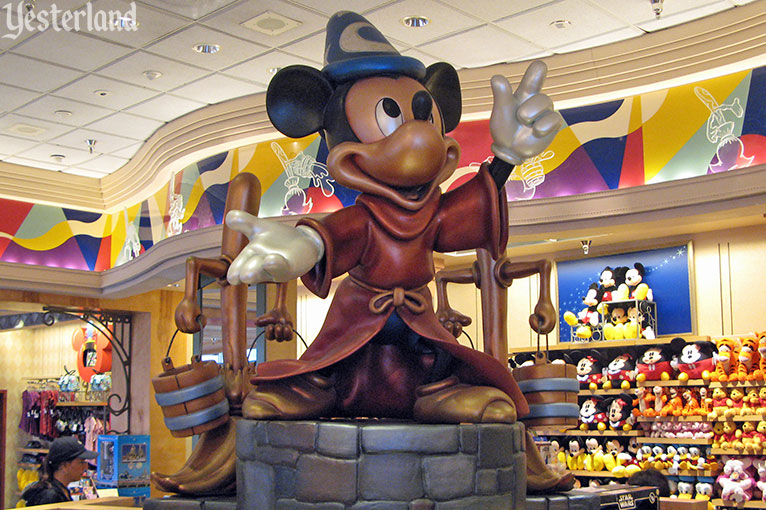
Photo by Werner Weiss, 2011 Mickey from Fantasia (1940) at Mickey’s of Hollywood, Walt Disney World |
|||||
|
It’s Korkis’ prerogative (and responsibility) as the author to decide what to emphasize, what to keep brief, and what not to include at all. Let’s consider the Mickey Mouse Club. Korkis devotes six pages to the first Mickey Mouse Club, which was not a television program but a children’s club that Walt Disney licensed to movie theaters beginning in 1929. The original Mickey Mouse Club television series, which ran from 1955 to 1958, gets two-and-one-half pages. The New Mickey Mouse Club (1977-1978) is only mentioned as the show on which Wayne Allwine made his debut at the voice of Mickey Mouse. And the All New Mickey Mouse Club (1989-1994), which included Christina Aguilera, Britney Spears, and Justin Timberlake, isn’t mentioned at all. There’s a reasonable explanation. The 1929 Mickey Mouse Club and the original television series prominently involved Mickey Mouse, the subject of the book. The two later series used the Mickey Mouse Club name, but any connection to the character beyond that was insignificant. None of what I’ve written so far should be read as a negative. It’s just meant to let you know what to expect. If you like Mickey Mouse (and who doesn’t?), The Book of Mouse is well worth buying and reading. |
|||||
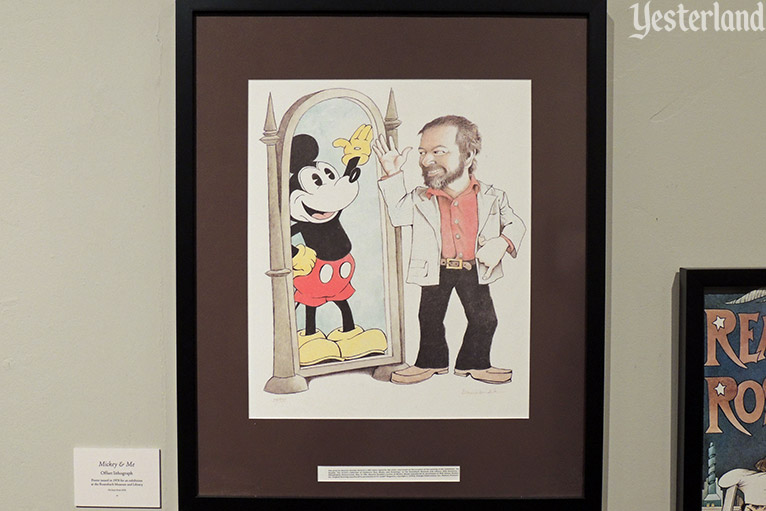
Poster issued in 1978 for an exhibition at the Rosenbach Museum and Library, Philadelphia “Mickey & Me” by Maurice Sendak (1928-2012) |
|||||
|
I’ll close this part of this article by quoting one of the many wonderful quotations in The Book of Mouse: Author and illustrator Maurice Sendak wrote: “Oh, I adored Mickey Mouse when I was a child. He was the emblem of happiness and funniness. You went to the movies then, you saw two movies and a short. When Mickey Mouse came on the screen and there was his big head, my sister said she had to hold onto me. I went berserk.” |
|||||
|
Author Interview I had a conversation with Jim about The Book of Mouse. Werner Weiss: You said you had fun every day writing the book. What made this so much fun? Jim Korkis: I’ve always loved the character of Mickey Mouse and I’ve always loved researching Disney history. I started writing the book assuming I knew a lot about Mickey so it would be reasonably easy, but, as I soon discovered, there are more things to know about Mickey than could ever be imagined—so it ended up taking several years. I am happy it was able to come out for Mickey’s 85th birthday. I think some of the things I found about Mickey that made me smile will make readers smile. Mickey, as Walt said, is a “happy little feller” and it was just so pleasant to try to trace his life’s accomplishments like a biography. WW: Why has Mickey remained popular for 85 years? JK: I think Mickey is just an appealing character. He is loyal, brave, kind, curious, energetic and so much more. He really is an extension and reflection of everything that was good about Walt. In addition, his physical design is appealing as well. I think basically we would all like to be like Mickey Mouse or have him as a best friend. I don’t think you can say that about any other animated character. He has adapted to every generation, whether he was Disco Mickey or Hipster Mickey. WW: I like artist Jerrod Maruyama’s Hipster Mickey, with his earbuds, Starbucks-style cup, and hipster glasses. I’m glad that Disney isn’t just letting Mickey languish as a corporate logo and relic of the past. Also, they’re once again making new Mickey Mouse cartoons for the Disney Channel and the Internet. Do you like these short films? JK: I like the fact that the Disney Company is trying to capture younger audiences to the joy of Mickey using the techniques that they enjoy including Flash animation, quick cuts, exaggerated humor, angular design, etc. In the cartoons I have seen, I think Mickey’s spirit is still very much there. I definitely do not think they have captured the character of Goofy, for instance. I think they are way off base there, but I was just re-watching some of these Mickey short cartoons recently and it is Mickey. Of course, my favorites are the black-and-white Mickey cartoons of the early 1930s, like Two Gun Mickey. WW: I agree with you about the surly Goofy in No Service, one of the new shorts. But, overall, the new shorts capture some of the spirit of the oldest Mickey Mouse shorts, though at a manic pace. The background art is wonderful, and the bold Terrytoons’ Tom Terrific-era look of the characters works well with the limited character animation. JK: I know some fans hate the new Mickey cartoons but I think the people involved have put a lot of thought and artistry into them. I still haven’t heard if there is any feedback that young people like them. WW: How do you feel about the talking, blinking Mickey Mouse character who now meets guests in his “dressing room” at the Magic Kingdom’s Town Square Theater? JK: I still haven’t seen the character. I grew up with the pantomime Mickey who was just fine, as far as I was concerned. As amazing as the technology is, I wonder if the Disney Company has thought about the fact that foreign visitors have heard Mickey speak their language perfectly, but now when they talk to Mickey, he can only talk in English. So far, Mickey’s range of expressions is limited… something I talk about in the book when I mention the short-lived experiment of trying to use a tape recorder in the costume… and so there is always the challenge to find the appropriate response. WW: I thought the talking Mickey would be creepy, but, after actually seeing him in the meet-and-greet setting, I really liked how he came across. While writing the book, what did you discover that you didn’t expect? JK: Just how much has been written about Mickey in the 1930s and is long forgotten. How much Walt really thought of Mickey as not his alter ego but as his child and a living, breathing separate being. How many urban legends we took for granted… like Walt got an award from the League of Nations for the creation of Mickey and that “Mickey Mouse” was the codeword for the D-Day invasion and they were completely wrong. Every day was a new discovery. Clarence Nash, the voice of Donald Duck, doing the voice of Mickey for American Motors car commercials even though Jimmy MacDonald, the official voice of Mickey, was there at the same sections doing other voices. WW: There are a lot great details in your book. JK: Hopefully, there is enough in the book to please everyone. |
|||||
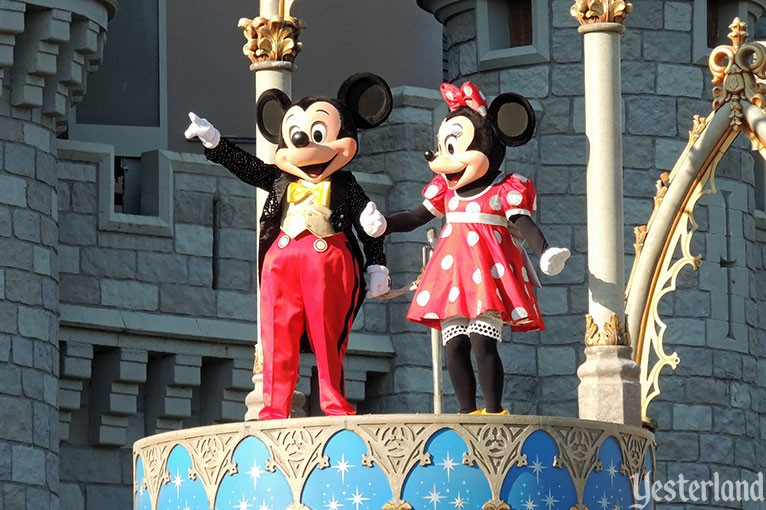
Photo by Werner Weiss, 2013
Dream Along with Mickey at Magic Kingdom Park, Walt Disney World |
|||||
|
Contents of The Book of Mouse MOUSE-CE-LLANEOUS
MOUSE-KA-TALES MICKEY AT THE MOVIES
MICKEY MOUSE ANNOTATED FILMOGRAPHY (1928-2013)
MICKEY AT THE PARKS
SPEAKING OF THE MOUSE FINAL WORD: WALT DISNEY ON MICKEY MOUSE |
|||||
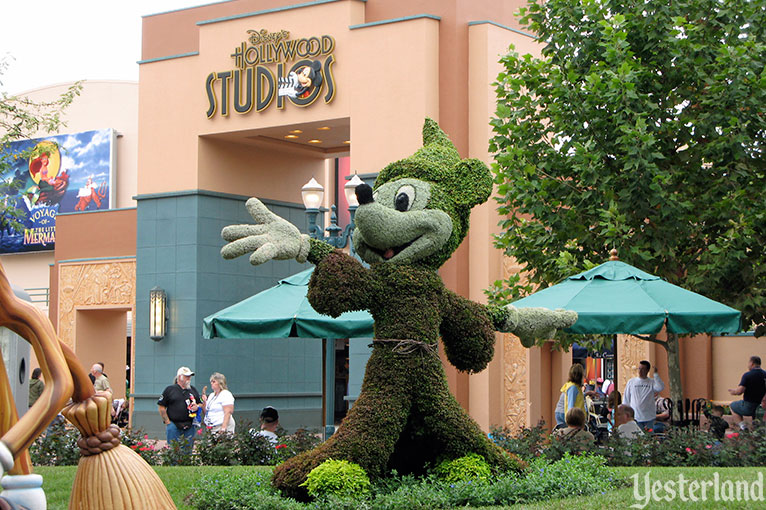
Photo by Werner Weiss, 2013
Topiary Mickey at Disney’s Hollywood Studios |
|||||
|
About the Author |
|||||

Photo by Werner Weiss, 2011 Author Jim Korkis |
|||||
|
Jim Korkis is a well-respected Disney historian who has written hundreds of articles and given hundreds of presentations about all things Disney for over three decades. He is the author of several books about animation and Disney, and his research has received international acclaim for documenting previously unexplored areas of Disney history. The Disney Company makes frequent use of Korkis’ extensive expertise and knowledge for special projects like the syndicated Secrets of the Animal Kingdom television series and such popular videos as Walt’s Love of Steam Trains. Korkis is also a regular contributor to Disney’s Mickey Monitor and Disney Files periodicals. Disney awarded Korkis the prestigious Partners in Excellence award in 2004. |
|||||
|
Where to Buy the Book The Book of Mouse is available as a 6" x 9" paperback or as ebook editions for Kindle, Kobo, Nook (from Barnes & Noble), and iBooks (from Apple). Four current titles by Jim Korkis are available from Amazon in paperback and for Kindle. Please use the links below. |
|||||
|
|||||
|
|||||
|
|
|||||
|
|
|||||
© 2013-2104 Werner Weiss — Disclaimers, Copyright, and Trademarks Updated July 11, 2014. Disclosure per FTC guidelines: Werner Weiss received a review copy of The Book of Mouse: A Celebration of Walt Disney’s Mickey Mouse. Mr. Weiss does not receive any financial consideration from Jim Korkis or Theme Park Press. |
|||||
